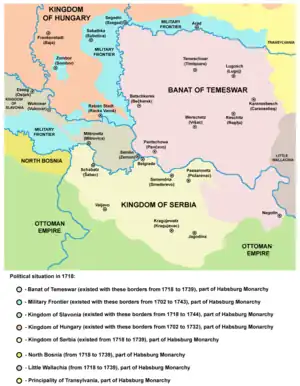 The central Balkans in 1718. Territories passed from the Turks to the Habsburg monarchy were:
Territory passed from Wallachia to the Habsburg Monarchy: | |
| Context | |
|---|---|
| Signed | 21 July 1718 |
| Location | Passarowitz, Habsburg Kingdom of Serbia (now Požarevac, Serbia) |
| Mediators | |
| Parties | |



The Treaty of Passarowitz, or Treaty of Požarevac, was the peace treaty signed in Požarevac (Serbian Cyrillic: Пожаревац, German: Passarowitz), a town that was in the Ottoman Empire but is now in Serbia, on 21 July 1718 between the Ottoman Empire and Austria of the Habsburg monarchy and the Republic of Venice.[1]
The treaty saw the cession of several Ottoman territories to the Habsburgs, and it was regarded in its time as an extraordinary success and source of pride in Vienna.[2]
Background
Between 1714 and 1718, the Ottomans had been successful against Venice in Ottoman Greece and Crete (Ottoman–Venetian War) but had been defeated at Petrovaradin (1716) by the Austrian troops of Prince Eugene of Savoy (Austro-Turkish War of 1716–1718).
Peace was arranged with the intervention of Great Britain and the Dutch Republic, and the treaty was signed by Sir Robert Sutton and Jacob Colyer on behalf of their governments.[3] The other signatories were
- Damian Hugo, Count of Virmont and Michael von Talmann for Austria,
- Vendramino Bianchi and Carlo Ruzzini for Venice
- Silindar Ibrahim–aga and Mehmed–efendija for the Ottoman Empire.

Terms
The Ottoman Empire lost the Banat of Temeswar, western Wallachia, northern Serbia (including the fortress town of Belgrade), and northern part of Bosnia, namely the region of Posavina to the Habsburgs.[3] The Habsburgs also received assurances that their merchants could operate in the Ottoman domain and that Catholic priests would regain revoked privileges, which allowed the Habsburg emperor to interfere in Ottoman affairs through connections with the church community and by championing the Catholic faith.[4]
Venice ceded the Morea, its last remaining outposts in Crete, and the islands of Aegina and Tinos. Venice retained only the Ionian Islands (with Ottoman-occupied Kythira added to them), and the cities of Preveza and Arta on the Epirote mainland. In Dalmatia, Venice made some small advances by taking the areas of Imotski and Vrgorac in the Hinterland.
Aftermath
The treaty gave the Habsburgs control over the northern part of present-day Serbia, which they had temporarily occupied during the Great Turkish War between 1688 and 1690. The Habsburgs established the Kingdom of Serbia as a crown land. The Habsburgs also formed the Banat into another crown land.[5]
Austrian control lasted 21 years, when the Turks won the Austro-Russian–Turkish War (1735–39). In the 1739 Treaty of Belgrade, the Ottoman Empire regained northern Bosnia, Habsburg Serbia (including Belgrade) and southern parts of the Banat of Temeswar, and Oltenia was returned to Wallachia.
See also
References
- ↑ Ingrao, Samardžić & Pešalj 2011.
- ↑ Setton, Kenneth Meyer (1991). Venice, Austria, and the Turks in the Seventeenth Century. Philadelphia: American Philosophical Society. pp. 449–450. ISBN 0871691922.
- 1 2 Setton (1991), 449.
- ↑ Kia, Mehrdad (2017). The Ottoman Empire: A Historical Encyclopedia. Vol. 1. Santa Barbara, California: ABC-CLIO. p. 44. ISBN 978-1610693899.
- ↑ Ćirković 2004, p. 151.
Sources
- Hochedlinger, Michael (2013). Austria's Wars of Emergence: War, State and Society in the Habsburg Monarchy, 1683–1797. London & New York: Routledge.
- Ćirković, Sima (2004). The Serbs. Malden: Blackwell Publishing.
- Ingrao, Charles; Samardžić, Nikola; Pešalj, Jovan, eds. (2011). The Peace of Passarowitz, 1718. West Lafayette: Purdue University Press.
External links
- "Treaty of Passarowitz". Encyclopædia Britannica. 14 July 2023.
- Text of treaty in English
